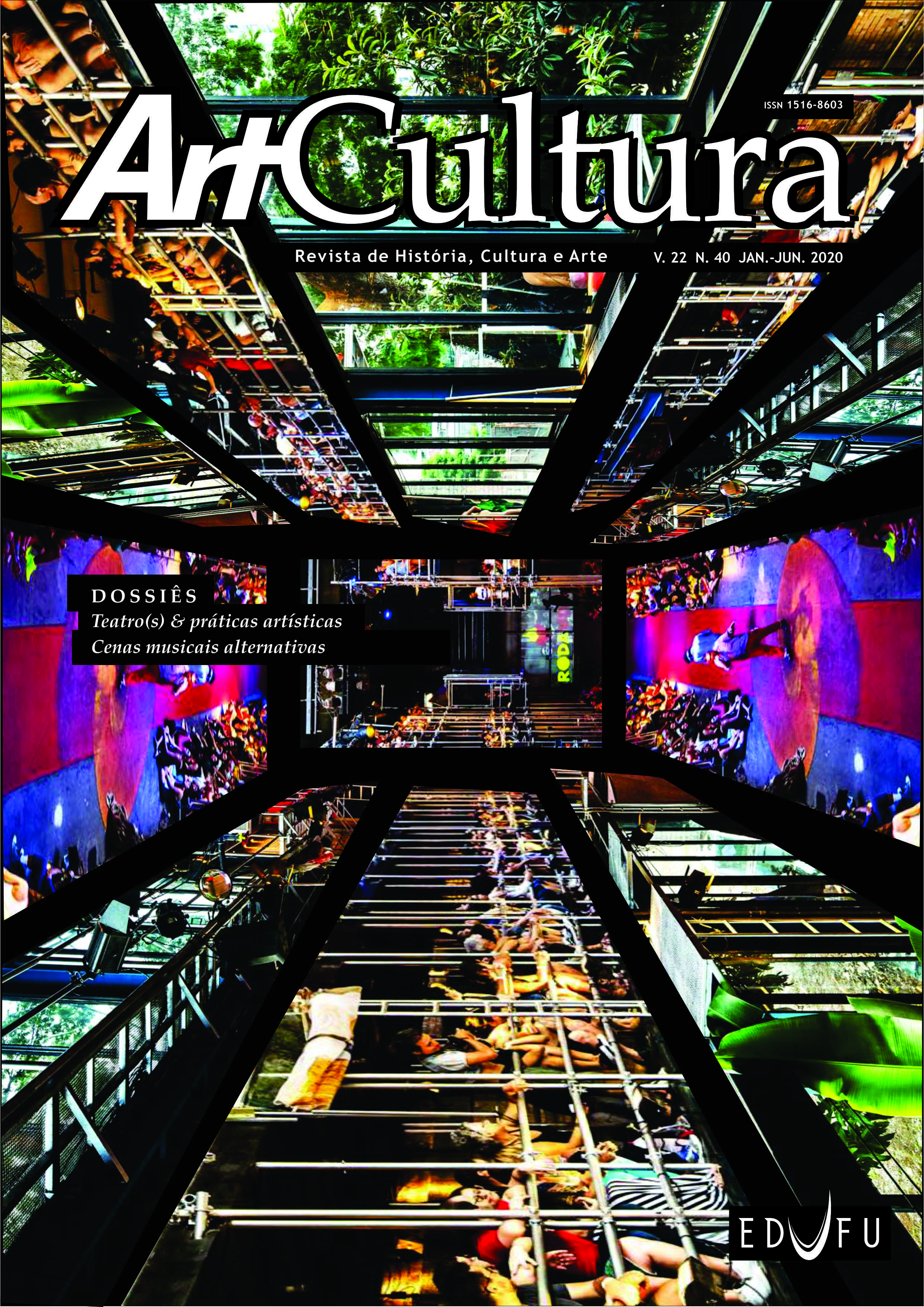Anarchist art in post-Second War: The Living Theatre and Laboratório de Ensaios
DOI:
https://doi.org/10.14393/artc-v22-n40-2020-56965Keywords:
anarchist art, The Living Theater, Laboratório de Ensaios.Abstract
Through two artistic movements created after the Second World War (The Living Theater and Laboratório de Ensaios), this article analyzes the way some anarchists promoted actions of transgression and experimentation of anarchic utopia. Artistic practices allowed the construction of a field of experimentation in which libertarian ideas could be carried out, experienced and propagated, deconstructing the values associated with war, such as darkness, borders and individualism. This conception of art, based on the alliance between aesthetics and life, did not start from an exclusively anarchist elaboration, but was appropriated by the militants as a way of combating the alienation and authoritarianism of the current society. Aesthetics, with its inexhaustible potential to instruct and encourage action, has become a tool for stimulating libertarian sensitivity.
Downloads
References
AVELINO, Nildo. Anarquistas: ética e antologia de existências. Achiamé: Rio de Janeiro, 2004.
BECK, Julian. El Living Theatre. Madrid: Fundamentos, 1974.
BUBER, M. Histórias do Rabi. São Paulo: Perspectiva, 1995.
BUBER, Martin. Paths in utopia. London: Routledge & Kegan Paul, 1949.
CAGE, John e RETALLACK Joan. Musicage: cage muses on words, art, music. John Cage in Conversation with Joan Retallack. Hanover: University Press of New England, 1996.
CAGE, John. A year from monday. Middletown: Wesleyan University Press, 1967.
CAGE, John. I–VI: John Cage. Cambridge: Harvard University Press, 1990.
CARVALHO. Sérgio. Isto é um pistom. Isto pode fazer muito barulho. E pode fazer jazz. Mas v. sabe mesmo o que é jazz? Dealbar, ano I, n. 2, São Paulo, mar. 1966.
Dealbar, ano I, n. 6, São Paulo, jul. 1967.
Dealbar, ano I, n. 05, São Paulo, set. 1967.
Dealbar, ano II, n. 8, São Paulo, out. 1967.
Dealbar, ano II, n. 10, São Paulo, dez. 1967.
GITLIN, Todd. The sixties: years of hope, days of rage. New York: Bantam Books, 1987.
INNES, Christopher. Holy theatre: ritual and the avant garde. Cambridge: Cambridge University Press, 1981.
KOPESKY, Waldyr. Nós. Dealbar, ano I, n. 4, São Paulo, jan. 1967.
L’adunata dei Refrattari, ano XXXVIII, n. 45, Nova York, nov. 1959.
L’adunata dei Refrattari. Dinamica sociale, ano XLVII, n. 15, Nova York, jul. 1968.
MALINA, Judith. Diário de Judith Malina: o Living Theatre em Minas Gerais. Belo Horizonte: Arquivo Público Mineiro, 2008.
MATTOS, Manoel José. Conversa sobre arte contemporânea. Dealbar, ano I, n. 3, São Paulo, mar. 1966.
MIDDLETON, Deborah Kathleen. The theatre of affect. Tese (Doutorado em Filosofia) – Universidade de Hull, Hull, 1993.
PASSETTI, Edson. Paradise now. Verve, n. 14, São Paulo, 2008.
PASSOS, Souza. O sentido artístico do anarquismo. A Plebe, ano XXXIII, n. 31, São Paulo, fev. 1951.
PENNER, James. The Living Theatre and its discontents: excavating the somatic utopia of Paradise Now. Ecumenica, v. 2, n. 1, 2009.
QUARTA, Cosmio. Utopia: gênese de uma palavra-chave. Revista Morus: utopia e renascimento, n. 3, Campinas, 2006.
RIBEIRO, Cristina Sanches. The Living Theatre e a criação coletiva: intersecções no teatro brasileiro. Dissertação (Mestrado em Teatro) – Udesc, Florianópolis, 2016.
RODRIGUES, Edgard. Entre ditaduras (1948-1962). Rio de Janeiro: Achiamé, 1993.
RODRIGUES, Thiago e SIMÕES, Gustavo. Para além do concerto: uma nota sobre a anarquia de John Cage. Verve, n. 29, São Paulo, 2016.
SIMÕES, Gustavo. Uma conversa com Judith Malina. Ecopolítica, n. 13, São Paulo, 2015.
VALVERDE, Antonio. Socialismo libertário, educação e autodidatismo: entrevista-depoimento com Jaime Cubero. Educação e Pesquisa, v. 34, n. 2, São Paulo, 2007.
VARGAS, Maria Thereza. Teatro operário na cidade de São Paulo. São Paulo: Secretaria Municipal de Cultura, Departamento de informação e documentação artísticas do Centro de Pesquisa de Arte Brasileira, 1980.
VIANNA, Allyson Bruno. Anarquismo em papel e tinta: imprensa, edição e cultura libertária (1945-1968). Tese (Doutorado em História) – UFC, Fortaleza, 2014.
Downloads
Published
How to Cite
Issue
Section
License
Autores que publicam nesta revista concordam com os seguintes termos da licença Creative Commons, adotada a partir da ArtCultura, v. 21, n. 39 (jul.-dez. 2019).
CC BY-NC-ND 4.0: o artigo pode ser copiado e redistribuído em qualquer suporte ou formato. Os créditos devem ser dados ao autor original e mudanças no texto devem ser indicadas. O artigo não pode ser usado para fins comerciais. Caso o artigo seja remixado, transformado ou algo novo for criado a partir dele, ele não pode ser distribuído.
Autores têm autorização para assumir contratos adicionais separadamente, para distribuição não exclusiva da versão do trabalho publicada nesta revista (ex.: publicar em repositório institucional ou como capítulo de livro), com reconhecimento de autoria e publicação inicial nesta revista.


